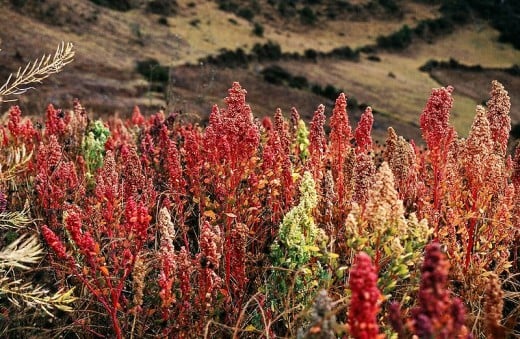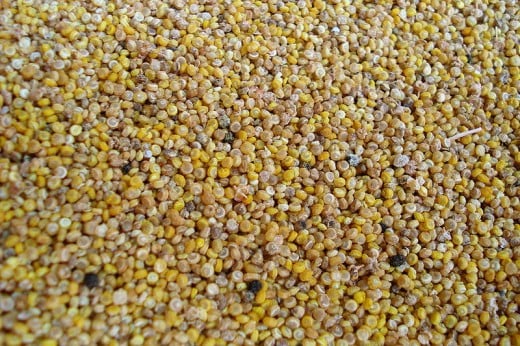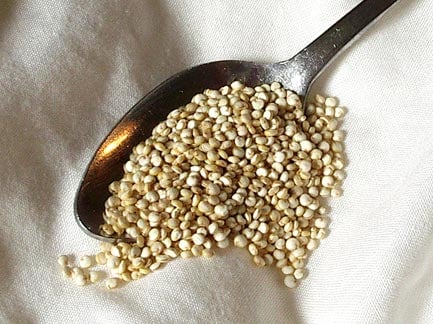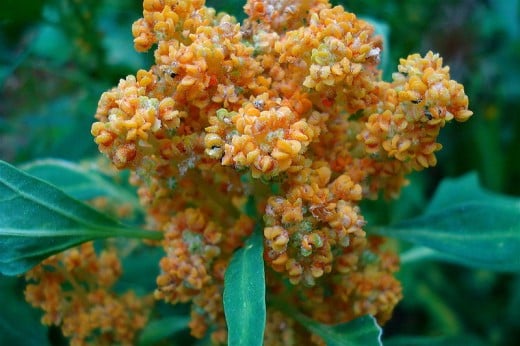What are the Benefits of Quinoa
Where did Quinoa Originate
Quinoa (keen wah) has been grown and harvested in the Andean regions of South America for 6,000 years. The Inca grew it as a foodstuff and even held in very high esteem. By Inca standards the top three foods were Quinoa, Potato, and Maze, in that order.
In fact the Inca word for Quinoa (our use is based on Spanish) is chisaya mama. Loosely translated this means "mother of all grains." In pre-Columbian times the reigning emperor would sow the first seeds of spring in a religious ceremony involving the use of golden tools.
Quinoa is not a grain per se, being more closely related to beets and spinach. It's botanical name is Quinoa making it a member of the Goosefoot family and in reality a herbaceous plant.
Almost all quinoa grown comes from Peru, Bolivia, or Ecuador.




Nutritional Value
Quinoa is almost singular in it's near complete nutritional value. It has a high protein value (12% ~ 18%) consisting of just the right complement of amino acids for human consumption. It also contains the right amount of dietary fiber, phosphorus, magnesium, and iron.
Three and a half ounces contain 64 grams of carbohydrate, 52 grams of starch, 7 grams dietary fiber, 6 grams of fat, 3.3 grams of polyunsaturated fat, 14 grams of protein, 13 grams of water and the following complement of vitamins and minerals.
That same three and a half ounces contain the Recommended Daily Allowance of the following:
- 28% of B1
- 21% of B2
- 38% of B6
- 46% B9
- 16% Vitamin E
- 37% Iron
- 53% Magnesium
- 65% Phosphorus
- 31% Zinc
Quinoa has such a complete nutritional profile that NASA is studying the plant for inclusion in it's Controlled Ecological Life Support System.
Best Growing Conditions
Quinoa is easy to grow with few natural enemies. It "loves" high altitudes and can easily be cultivated at elevations up to 4,000 meters or 13,100 feet.
Even so, it grows best
in well-drained soils and requires a relatively long growing season compared to other grains.
Eating Quinoa
Both the seeds and the leaves of the plant can be eaten. Those who have eaten unwashed quinoa report feeling a numbness in the lips and tongue; unwashed quinoa can also have a laxative effect so soaking and washing should be considered necessary.
Problems with numbing and gastric upset have not been reported by those eating the soaked and rinsed quinoa (see above). However, others have reported mild digestive distress from eating too many of the leaves regardless of cleaning.
Quinoa has a slightly nutty flavor and a fluffy texture when cooked.
Preparing Quinoa for Consumption
Like beans, quinoa should be soaked in water overnight before cooking. Unlike beans this is not in order to soften or remove some of the sulfurous compounds found in beans. Rather the soaking is necessary to remove a toxic coating of bitter-tasting saponins. Though this toxin is quite bitter and only mildly irritating to humans it has a very definite benefit; birds don't like the taste and therefore leave the seeds of the plant alone.
This in turn means the plant needs very little tending.
To prepare Quinoa the seeds should be soaked overnight, the water then changed and soaked again for about an hour, and finally rinsed in running water and strained in a wire-mesh colander.
In the video below the hostess simply rinses the quinoa under a running tap in a wire mesh sifter, but I think it's better to be safe and make sure all the saponins are rinsed away; thus my three rinse recommendation.
You can tell when the saponins have been removed when the water no longer has a cloudy and soapy appearance.
Cooking Quinoa
Quinoa requires the same amount of water as and slightly shorter cooking times than white rice. Where white rice is cooked for twenty minutes quinoa takes ten to fifteen minutes to cook. Quinoa can even be cooked in a "specific use" appliance like a rice cooker with excellent results. Naturally, quinoa can be used in dishes as a substitute for rice.
Quinoa as Cereal Grain
Quinoa can be eaten as a breakfast cereal, as a type of pilaf, and is a wonderful complement to bitter greens such as Kale.
Quinoa can be cooked like oatmeal or eaten as a cold (prepared dry) cereal with milk.
Quinoa flour makes an excellent substitute for wheat flour and, when mixed with potato starch and sorghum flour it is a first rate replacement for wheat bread; excellent for those on a gluten restricted diet.
Finally the raw grains can be malted (or sprouted) in as little four hours making the seed an excellent addition to salads or other cold foods.
Quinoa Recipes
Quinoa Pilaf
Ingredients
- 1 Cup quinoa, rinsed well (see preparing section above)
- 1/4 Cup pine nuts
- 2 Tablespoons extra-virgin olive oil
- 2 cloves garlic, thinly sliced
- 1/3 Cup chopped fresh parsley (or cilantro)
- 1/4 Cup raisins
- 1 Tablespoon fresh lemon juice (fresh squeezed is best)
- Kosher salt and freshly ground pepper
Directions
- Add the quinoa to a dry saucepan and cook over medium heat until
toasted, about 2 minutes.
- Add 1 3/4 Cups water (or use low-sodium
chicken broth) and bring to a boil.
- Once at the boil reduce the heat to medium-low and
simmer, covered, until the liquid is absorbed or about 10 to 15 minutes.
- Remove from the heat and let sit, covered, about 2 minutes.
- Toast the pine nuts in a dry skillet over medium-high heat,
stirring, until golden, about 3 minutes; transfer to a plate.
- Add the
olive oil and garlic to the skillet and cook over medium heat, stirring,
until golden, about 2 minutes.
- Transfer the garlic to the plate, reserving the oil.
- Fluff the quinoa with a fork. Add the pine nuts, garlic, reserved oil, parsley, raisins and lemon juice. Season with salt and pepper and toss.
Can be eaten warm or cold.
Quinoa and Black Beans
Ingredients
- 1 teaspoon vegetable oil
- 1 onion, chopped
- 3 cloves garlic peeled and chopped
- 3/4 Cup uncooked quinoa
- 1 1/2 Cups vegetable broth
- 1 teaspoon ground cumin 1/4 teaspoon cayenne pepper
- salt and pepper to taste
- 1 Cup frozen corn kernels
- 2 (15 ounce) cans black beans rinsed and drained
- 1/2 Cup chopped fresh cilantro
Directions
- Heat the oil in a medium saucepan over medium heat.
- Stir in the onion and garlic, and sauté until lightly browned.
- Mix quinoa into the saucepan and cover with vegetable broth.
- Season
with cumin, cayenne pepper, salt, and pepper.
- Bring the mixture to a boil. Cover and simmer 20 minutes
- Stir frozen corn into the saucepan, and continue to simmer about 5
minutes until heated through.
- Mix in the black beans and cilantro.
Like the recipe above this can be served warm or chilled and served like a salad.
Hot Quinoa Poridge
Ingredients
- 1 Cup Quinoa (red or amber)
- 2 Cups Water
- 1/2 Cup Apples; thinly sliced
- 1/3 C Raisins
- 1/2 teaspoon Cinnamon
- Milk or cream
- Honey or brown sugar
Directions
- Rinse quinoa (see preparation above) and add to water; bring to a boil.
- Reduce heat to a simmer and cook for 5
minutes.
- Add apples, raisins and cinnamon. Continue to simmer until water is
absorbed.
- Serve with milk or cream and sweeten to taste with honey or brown sugar.
Note: Due to the reduced cooking time this will have a bit of an Al Dente bite to it.
Availablity
When Quinoa was introduced in the U.S. (about five years ago) it was expensive and hard to find. No longer. It's now pretty easy to find and the price per pound has dropped significantly. The last time I purchased a pound in bulk I think I paid $1.29 per pound. This is comparable to high quality brown rice.
I can usually find it, in bulk (which is the best way to buy it), at most health-food or organic grocery stores. You can also find quinoa in larger retail groceries stores down the specialty food aisle.
Disclaimer
The author has not been compensated in any way for the writing of this article either directly, with discounts, or freebies. The author does stand to make a slight profit on ads running alongside this article, but the author has no control over the content of those ads.












